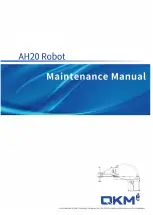
Chapter 7: Optional Equipment Installation
7.1 Installing End-Effectors
The user is responsible for providing and installing any end-effector or other end-of-arm tool-
ing. End-effectors can be attached to the tool flange using four M6 screws. See Tool Flange
Dimensions for Cobra 350 Robots (Units in mm) on page 122 for a detailed dimension draw-
ing of the tool flange.
A 6 mm diameter x 12 mm dowel pin (user-supplied) fits in the through-hole in the tool flange
and can be used as a keying or anti-rotation device in a user-designed end-effector.
If hazardous voltages are present at the end-effector, you must install a ground connection
from the base of the robot or the outer link to the end-effector. See Grounding the Robot System
on page 75.
NOTE:
A threaded hole is provided on the tool flange. The user may attach a
ground wire through the quill, connecting the outer link and the tool flange.
7.2 Removing and Reinstalling the Tool Flange
The tool flange can be removed and reinstalled. If the flange is removed, it must be reinstalled
in exactly the same position to avoid losing the calibration for the system.
There is a setscrew on the flange that holds the rotational position of the flange on the quill
shaft. The setscrew contacts a flat section of the quill shaft. Follow the procedures below to
remove and replace the flange assembly.
Removing the Flange
1. Turn off high power and system power to the robot.
2. Remove any attached end-effectors or other tooling from the flange.
3. Use a 2.5 mm hex driver to loosen the setscrew. See the following figure.
4. Loosen the two M4 socket-head cap screws.
5. Slide the flange down slowly until it is off the shaft.
05624-000 Rev. K
Cobra 350 User's Guide
93











































